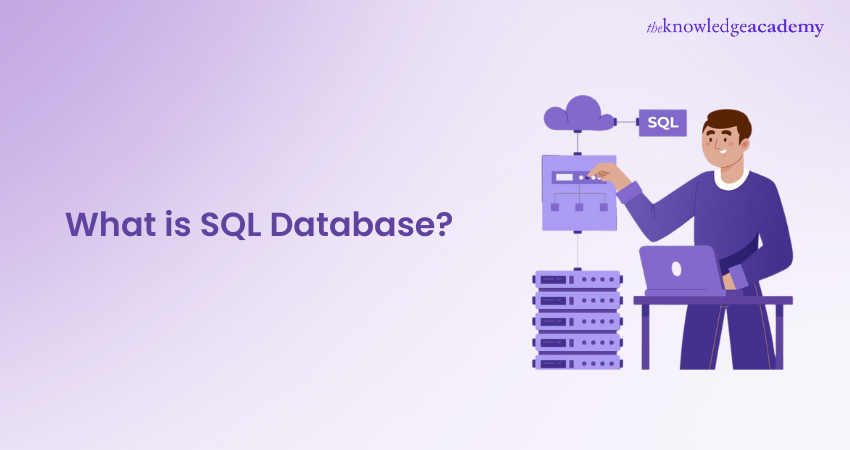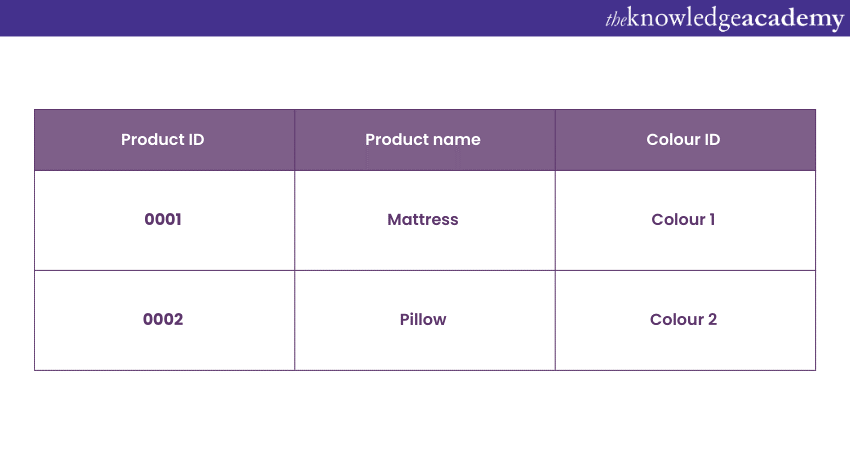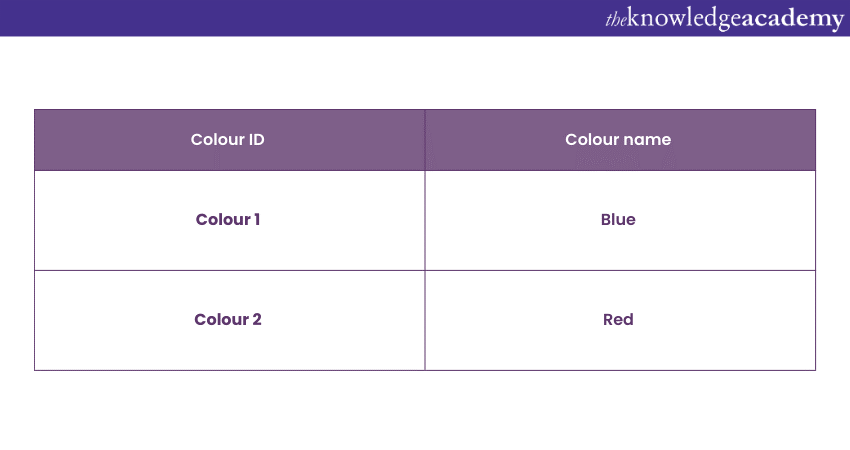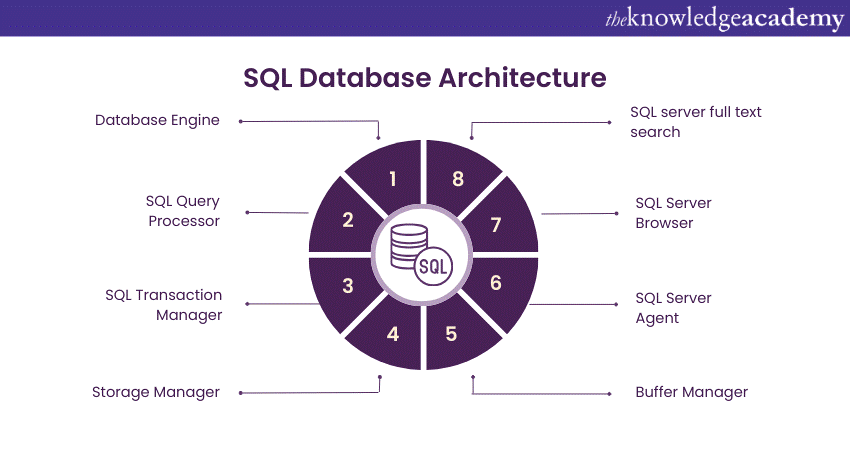We may not have the course you’re looking for. If you enquire or give us a call on +44 1344 203999 and speak to our training experts, we may still be able to help with your training requirements.
We ensure quality, budget-alignment, and timely delivery by our expert instructors.

Structured Query Language (SQL) Databases are at the heart of modern data storage and management, powering everything from simple applications to complex enterprise systems. SQL Databases organise data into structured tables, making it easy to retrieve, manipulate, and analyse information efficiently. As the foundation of many Relational Database Management Systems (RDBMS), SQL allows users to perform operations like querying data, updating records, and managing Database structures.
Popular SQL Databases include MySQL, PostgreSQL, Microsoft SQL Server, and Oracle. Whether you're a developer, data analyst, or business professional, understanding SQL Databases is essential for navigating today’s data-driven world. This blog explores how SQL Databases work, their key features and advantages, and why they remain critical in technology and business.
Table of Contents
1) What is SQL Database?
2) What are the Components of a SQL System?
3) How Does SQL Work?
4) What are SQL standards?
5) Advantages of Using SQL Database
6) List of SQL Database
7) Key Features of SQL Database
8) SQL vs. NoSQL Databases Differences
9) Understanding SQL Database Architecture
10) Exploring SQL Commands
11) Use of SQL Database
12) Is Excel a SQL Database?
13) Which SQL Database is Best?
14) Conclusion
What is SQL Database?
Before diving deep into SQL Database, you need to understand What is SQL? SQL is a standardised Programming Language. This language is specifically designed for managing data held in an RDBMS or for performing various operations on data within an RDBMS. It often refers to any database that utilises the Components of SQL Server to query data. However, more specifically, it is used to describe a particular type of RDBMS developed by Microsoft, namely MS SQL Server.
It lets you to retrieve, store, and manipulate data that are organised into tables with rows and columns. Each table in an SQL Database corresponds to a different type of entity, and the columns within these tables represent different types of attributes. The power of SQL lies in its simplicity and universality. It provides a straightforward way to interact with data.
What are the Components of a SQL System?
Relational Database Management Systems (RDBMS) like MS SQL Server, MySQL, and MS Access utilize Structured Query Language (SQL) to efficiently store and manage data, as outlined in the SQL Cheat Sheet. In the process of creating a database in SQL, these systems are composed of interconnected database tables that optimise data storage through relationships. Here’s an overview of the components within such a system:
SQL Table
The fundamental building block of an RDBMS is the SQL table, which is organized into rows and columns. These tables allow database engineers to establish relationships between different sets of data through the use of types of keys in SQL, thereby optimizing storage space. For instance:
Product Table:

Colour Table:

SQL Statements
SQL Statements, also known as queries, are the instructions understood by RDBMS. They are constructed using various SQL language elements like identifiers, variables, and search conditions. An example of an SQL statement is:
INSERT INTO Mattress_table (brand_name, cost)
VALUES('A','499');
Stored Procedures
Stored procedures are sets of SQL statements saved within the database to enhance performance and efficiency. Developers use these to perform routine operations without rewriting the same code. For example, a stored procedure could be created to update sales tables across different applications.
How does SQL work?
SQL, or Structured Query Language, operates through a server that processes Database queries and returns results. The SQL process involves several key software components:
Parser
The parser begins by tokenising the SQL statement, replacing certain words with special symbols. It checks for:
a) Correctness: Ensuring the SQL statement adheres to SQL semantics, such as ending commands with a semi-colon. Missing semi-colons result in an error.
b) Authorisation: Confirm that the user has the necessary permissions to execute the query, such as admin rights for data deletion.
Relational Engine
Also known as the Query processor, the relational engine devises a plan for the most efficient data retrieval, writing, or updating. It may reuse methods from similar queries or generate new ones, translating the plan into an intermediate form called byte code, which relational databases use for efficient data handling. This process becomes even more effective when you Create a Database in Microsoft SQL Server, optimizing how data is processed and queried.
Storage Engine
The storage engine, or database engine, executes the byte code. It interacts with the database files on physical disk storage, reading and storing data as directed by the SQL statements. Once the operation is complete, the results are sent back to the application that made the request.
This structured approach allows SQL to manage complex databases effectively, ensuring data integrity and security while optimising performance.
What are SQL Standards?
SQL standards are formally established guidelines that define the Structured Query Language (SQL). These standards were adopted by the American National Standards Institute (ANSI) and the International Organization for Standardization (ISO) in 1986.
They serve as a blueprint for software vendors when creating SQL Database software, ensuring consistency and interoperability across different platforms and systems. By sticking to these standards, developers can write SQL code that is more likely to be portable between different database systems, which is important for the development of robust and scalable SQL Projects.
Advantages of using SQL Database
Using SQL Databases has several advantages, from increased flexibility to superior performance. Let's take a look at some of them below:
1) Easy to Maintain: SQL Databases offer built-in automation tools that streamline repair, control, and maintenance processes. This simplifies the work of Database Administrators and technicians, making it easier to proactively manage, update the Database, and handle tasks like Inserting Data in SQL efficiently. Additionally, external monitoring tools can be customised to meet each organisation's specific Database management needs.
2) Increased Efficiency: SQL Databases employ normalisation techniques to reduce data redundancy. This organisation of data eliminates anomalies related to data insertion, updating, and deletion, resulting in a more efficient and streamlined data structure.
3) Increased Flexibility: SQL Databases, with their standard Programming Language, provide the flexibility to modify the schema in real time. This enables seamless addition of tables and columns, renaming of relations, and various other changes without interrupting ongoing Database operations.
4) Better Performance: Relational Databases come equipped with an array of performance optimisation features. These features minimise memory usage, reduce storage costs, and harness high processor speed, ultimately accelerating database performance for all applications.
5) Improved Consistency: SQL Databases excel at maintaining data consistency across applications and server instances. They are particularly reliable in ensuring real-time consistency, a critical aspect for mission-critical applications processing important business transactions.
Overall, SQL Databases provide a robust foundation for data management, offering benefits such as flexibility, data consistency, reduced redundancy, enhanced performance, and simplified maintenance. These Advantages of SQL database make them a preferred choice for various applications and industries.
Simplify Data Management: Learn to Create Temp Tables in SQL Now!
List of SQL Database
From conventional systems using desktops to modern systems using the cloud, businesses use various relational databases. Let's explore some of them below:
1) Oracle Database: Oracle Database is a commercial closed-source relational database owned by Oracle Corporation. It is used extensively in various industries for large-scale applications. Oracle Database supports macOS, Windows, and Linux and is known for its robust data and server management capabilities, including automation.
2) MySQL: MySQL is a popular open-source SQL Database server known for its ease of use and wide usage in web application development. It offers both open-source and commercial enterprise versions, providing additional functionality through extensions and plugins.
3) Microsoft SQL Server: Microsoft's SQL Server is a widely used relational database system owned by Microsoft. It is commonly used for enterprise-level applications and supports both Windows and Linux Operating Systems. SQL Server allows access through SQL queries and graphical user interfaces, offering features like referential integrity, multi-version concurrency control, and high availability. Using a SQL Server Reporting Services Guide can enhance reporting and data visualization for effective analysis.
4) Using a PostgreSQL: PostgreSQL is an Object-Relational Database System (ORDBMS) designed to handle complex and diverse data models. It provides enterprise-grade features such as scalability, security, and automation support, accessible via a command-line interface or web access. The PostgreSQL Performance Tuning Guide highlights its support for numerous operating systems, including Windows, macOS, and various Linux distributions. For a quick reference to essential commands and functionalities, check out our PostgreSQL Cheat Sheet PDF.
These databases cater to a range of needs, from small-scale web applications to large enterprise-level systems, and offer diverse features and capabilities to meet specific requirements.
Learn PostgreSQL Architecture – Download the comprehensive PostgreSQL Architecture PDF today!
Key Features of SQL Database
In this section, you will learn about the key features of SQL Database:

1) Structured Query Language: SQL uses a standard language recognised globally for querying and manipulating databases. It simplifies complex queries and allows easier management of large chunks of data.
2) ACID Properties: SQL Databases adhere to Atomicity, Consistency, Isolation, and Durability (ACID) properties, ensuring data reliability even in the event of errors or failures.
3) Schema - based: They have a predefined schema. This requires the data to follow a specified structure. The schema outlines the logical view of the entire database.
4) Data Consistency and Integrity: They provide numerous constraints to ensure data consistency and integrity. How to Create a Primary Key in SQL is a common query, as primary key, foreign key, unique, and not null constraints are some examples.
5) Scalability and Performance: They are highly scalable, allowing for effective management of large data sets. They also provide high performance in managing structured data.
6) Support for Complex Queries: SQL offers comprehensive support for complex queries, making data analysis and manipulation easier.
7) Security: They come with robust security features. Permissions and roles can be assigned, ensuring only authorised individuals can access the data.
8) Transaction Control: SQL provides powerful transaction control language commands like COMMIT, ROLLBACK, and SAVEPOINT. This allows transactions to be managed with precision.
Begin your journey into database with our Introduction to MySQL
SQL vs. NoSQL Databases Differences
In contrast to SQL Databases, NoSQL Databases store data in a document format instead of tables. NoSQL Databases are designed to handle non-structured data types such as photos, videos, articles, and more in a single document, providing a flexible and scalable solution for managing diverse data sets.
a) Database Structure: SQL Databases typically use a structured schema with tables to store information, where data is organised into rows and columns. In contrast, NoSQL Databases employ a key-value pair or document-oriented approach to store all data in one place. Each document contains all relevant information related to a particular entity, and the key serves as a unique identifier, such as an employee email address.
b) Flexibility: NoSQL Databases offer greater flexibility in storing various data types without strict schema requirements. This flexibility allows users to store and access different data types within the same database instance, making it well-suited for applications with evolving data structures. However, this flexibility may require additional processing effort and storage space compared to relational databases.
c) Consistency: Ensuring data consistency is crucial for maintaining the integrity of a database. While relational databases guarantee strong consistency across server instances, some NoSQL Databases prioritise availability and partition tolerance over solid consistency. For example, in distributed NoSQL Databases like Redis, data may be temporarily inconsistent across nodes in exchange for improved availability and performance. Balancing consistency and availability is crucial when selecting the appropriate database solution for specific application requirements.
Understanding SQL Database Architecture
Before you try to work with SQL Database, you need to know the architecture of it:

1) Database Engine: This is the core component that controls data storage, manipulation, and processing. It handles transactions, locking, and concurrency to ensure data consistency and integrity.
2) SQL query Processor: This interprets and executes SQL queries. It comprises a command parser. It also consists of a query optimiser that determines the best method to carry out the task. It also has a query executor that implements the plan devised by the optimiser.
3) SQL transaction Manager: This manages the transactions occurring in the database to ensure the ACID Properties in DBMS are maintained. It handles the commitment or rollback of transactions. It also provides isolation levels to control the interaction between concurrent transactions.
4) Storage Manager: This handles the storage and retrieval of data in the database. It manages database files, pages, buffers, and transaction logs.
5) Buffer Manager: This manages the database's memory resources. It decides when to load data from the storage disk into memory and when to write modified pages back to the disk.
6) SQL server Agent: In the context of Microsoft's SQL Server, the SQL Server Agent automates jobs, alerts, and schedules.
7) SQL server Browser: Also specific to MS SQL Server, this component helps clients connect to the server. It provides important information like the server's IP address and the ports used for communication.
8) SQL Server Full Text Search: This is a specialised indexing and querying service for unstructured text stored in SQL Server Databases. This enables full text search capabilities within them.
Dive deeper into SQL by registering in our SQL Server Reporting Services (SSRS) Course.
Exploring SQL Commands
SQL commands are instructions which are used to communicate with the database and manipulate data. They are categorised into Data Definition Language (DDL), Data Manipulation Language (DML), and Data Control Language (DCL). They are categorised into Data Manipulation Language (DML), Data Control Language (DCL), and Data Definition Language (DDL). They are as follows:
1) Data Definition Language (DDL)
a) CREATE
b) CREATE DATABASE testDB;
c) CREATE TABLE Students (StudentID INT, StudentName VARCHAR(100));
2) ALTER: This command modifies an existing database object like a table.
a) ALTER TABLE Students ADD Email VARCHAR(255);
3) DROP: This command deletes an entire table or database.
a) DROP DATABASE testDB;
b) DROP TABLE Students;
3) Data Manipulation Language (DML): This is used to retrieve, store, modify, retrieve, delete, insert, and update data in a database. DML includes commands like:
a) SELECT: This command is used to select data from a database.
SELECT StudentName FROM Students;
b) INSERT: This command is used to insert data into a table.
INSERT INTO Students (StudentID, StudentName, Email) VALUES (1, 'John', 'john@example.com');
c) UPDATE: This command modifies existing records in a table.
UPDATE Students SET Email = 'john_new@example.com' WHERE StudentID = 1;
d) DELETE: This command removes existing records from a table.
DELETE FROM Students WHERE StudentID = 1;
3) Data Control Language (DCL): These commands deal with permissions and rights that users can grant or revoke. DCL includes commands like:
a) GRANT: This command provides user access privileges to a database.
GRANT SELECT, INSERT, DELETE ON Students TO 'user';
b) REVOKE: This command withdraws user access privileges given using the GRANT command.
REVOKE SELECT, INSERT, DELETE ON Students FROM 'user';
SQL commands also include SQL Operators, functions, constraints, and joins, enabling more complex operations and queries. You can learn about them in the following segments.
a) Operators
Operators perform operations on variables and values.
1) Arithmetic Operators: +, -, *, /, %
SELECT (15+10) AS Sum;
2) Comparison Operators: =, >, <, >=, <=, !=, <>
SELECT * FROM Students WHERE StudentID > 5;
3) Logical Operators: AND, OR, NOT
SELECT * FROM Students WHERE StudentID > 5 AND StudentName = 'John'
b) Functions
Functions are precompiled routines that perform an operation and return a single value.
1) Aggregate Functions: SUM(), COUNT(), AVG(), MIN(), MAX()
SELECT AVG(Grade) FROM Students;
2) Scalar Functions: UCASE(), LCASE(), MID(), LEN(), ROUND()
SELECT UCASE(StudentName) FROM Students;
c) Constraints
Constraints are used to specify the limit of the data type in the table.
1) ‘NOT NULL’, ‘UNIQUE’, ‘PRIMARY KEY’, ‘FOREIGN KEY’, ‘CHECK’, ‘DEFAULT’
CREATE TABLE Students(
StudentID int NOT NULL PRIMARY KEY,
StudentName varchar(255) NOT NULL,
Age int CHECK (Age>=18)
);
d) Joins
Joins combine rows from two or more than two tables, based on a related column.
1) ‘INNER JOIN’, ‘LEFT (OUTER) JOIN’, ‘RIGHT (OUTER) JOIN’, ‘FULL (OUTER) JOIN’
SELECT Orders.OrderID, Customers.CustomerName
FROM Orders
INNER JOIN Customers
ON Orders.CustomerID = Customers.CustomerID;
Use of SQL Database
SQL Databases are widely used in various domains for diverse purposes. Their structured organisation and robust querying capabilities make them an ideal choice for many applications. With the help of your SQL skills, you’ll be able to add value to the following sectors:
1) Data Management:
SQL Databases are primarily used for storing, managing, and retrieving data. They offer a systematic and organised approach to Data Management. This makes it easier to access, update, delete, and manipulate information as required. It also helps organisations to handle vast amounts of data efficiently.
2) Web Applications:
Nearly all Web Applications use databases to store user data and other related information. Whether it's an e-commerce site managing user profiles, orders, and product inventories, or a blogging platform handling post, comments, and likes, they are a staple in the Web Application domain.
3) Data Analysis:
They also play a critical role in Data Analysis. The structured nature of the data stored in SQL Databases makes it easy to perform analysis tasks. Analysts can extract meaningful insights from the data using the basic structure of SQL queries to support an organisation's decision-making processes.
4) Enterprise Systems:
Large enterprise systems like Customer Relationship Management (CRM), Human Resources Management Systems (HRMS), and Enterprise Resource Planning (ERP) extensively use SQL Databases. These systems handle vast amounts of data that need to be organised in a structured manner for efficient processing.
5) Government and Defence:
Government agencies and defence organisations use SQL Databases for handling diverse data types, such as census data, social security information, defence-related intelligence data, and more. The robust security measures offered by them make them a preferred choice in these sectors.
Take your SQL skills to the next level with our course on Advanced SQL Courses.
Is Excel an SQL Database?
No, Excel is not an SQL Database. It is a spreadsheet tool for data analysis and visualisation, while SQL Databases are designed for structured data storage and management using relational tables and queries.
Which SQL Database is Best?
The best SQL Database depends on your needs. MySQL and PostgreSQL are excellent for open-source projects, Microsoft SQL Server suits enterprise applications, and Oracle Database is ideal for large-scale operations with advanced features.
Struggling with slow queries? Discover how PostgreSQL Query Optimization can help—grab the PDF!
Conclusion
SQL Databases are fundamental to managing structured data in today’s digital landscape. They offer efficiency, scalability, and robust tools for querying and managing data, including the BETWEEN Operator in SQL, which helps in filtering data within a specific range. By understanding their features, benefits, and use cases, you can harness SQL Databases to power applications, optimise workflows, and make data-driven decisions effectively.
Stand out with the right answers—practice SQL Interview Questions now!
Frequently Asked Questions
What are the top 3 Most Used SQL Databases?

The top 3 most used SQL Databases are PostgreSQL, MySQL and SQLite. These databases are widely recognised for their performance, features, and community support.
Is SQL Easier Than Coding?

SQL is considered user-friendly and easier to learn for many, especially for those not familiar with programming. It’s developed to be intuitive and straightforward, making it accessible to various professionals.
What are the Other Resources and Offers Provided by The Knowledge Academy?

The Knowledge Academy takes global learning to new heights, offering over 3,000 online courses across 490+ locations in 190+ countries. This expansive reach ensures accessibility and convenience for learners worldwide.
Alongside our diverse Online Course Catalogue, encompassing 19 major categories, we go the extra mile by providing a plethora of free educational Online Resources like News updates, Blogs, videos, webinars, and interview questions. Tailoring learning experiences further, professionals can maximise value with customisable Course Bundles of TKA.
What is The Knowledge Pass, and How Does it Work?

The Knowledge Academy’s Knowledge Pass, a prepaid voucher, adds another layer of flexibility, allowing course bookings over a 12-month period. Join us on a journey where education knows no bounds.
What are related Management Courses and blogs provided by The Knowledge Academy?

The Knowledge Academy offers various SQL Courses, including Introduction To SQL, Advanced SQL, SQL Server Reporting Services (SSRS) Masterclass and Introduction To MySQL Course. These courses cater to different skill levels, providing comprehensive insights into SQL Array.
Our Programming & DevOps Blogs cover a range of topics related to programming, offering valuable resources, best practices, and industry insights. Whether you are a beginner or looking to advance your programming skills, The Knowledge Academy's diverse courses and informative blogs have you covered.
Upcoming Programming & DevOps Resources Batches & Dates
Date
 Introduction to SQL Databases Training 10985C
Introduction to SQL Databases Training 10985C
Mon 12th May 2025
Mon 7th Jul 2025
Mon 15th Sep 2025
Mon 3rd Nov 2025
Mon 15th Dec 2025
Tue 27th Jan 2026
Mon 20th Apr 2026
Mon 20th Jul 2026
Mon 5th Oct 2026






 Top Rated Course
Top Rated Course



 If you wish to make any changes to your course, please
If you wish to make any changes to your course, please


